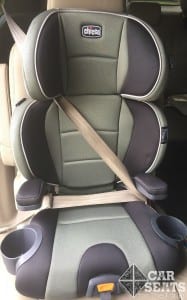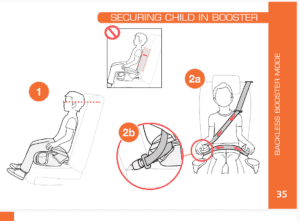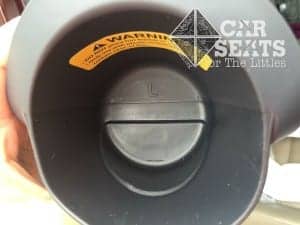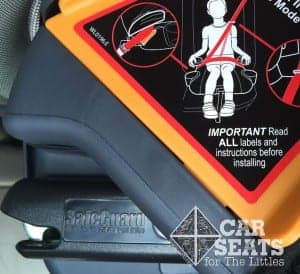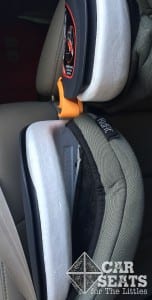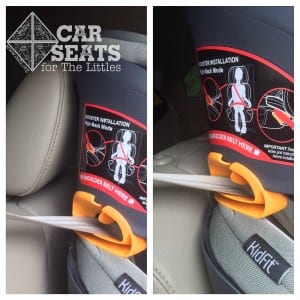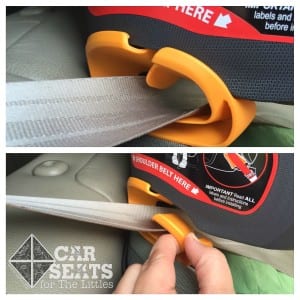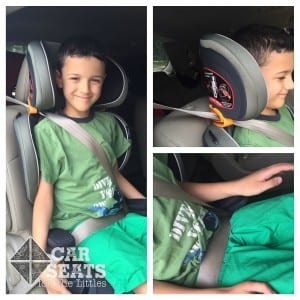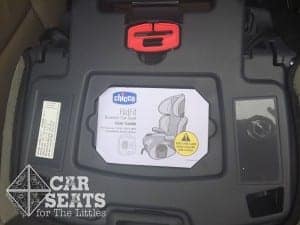Chicco’s product line includes the popular, easy-to-use KeyFit rear facing only car seat, then moves to the NextFit convertible car seat and also includes the MyFit combination car seat. The KidFit was Chicco’s first foray in the booster seat world. Let’s see how this booster stacks up!
CSFTL Quick Stats:
- High-back booster weight range, United States: 40-100 pounds. Note: older models had a different minimum weight, please check your manual to confirm your seat’s limit
- High back booster weight range: 40-100 pounds
- High back booster height range: 38-57 inches tall
- Backless booster weight range: 40-110 pounds
- Backless booster height range: 38-57 inches tall
- Highest shoulder guide position: 19.5 inches
- Expiration: 8 years from date of manufacture
- Can be used with an inflatable seat belt if the vehicle manual permits
- 2015 IIHS Best Bet
Features:
- Deluxe lower anchor connectors in high back and backless mode
- 10 headrest positions
- DuoZone Side-Impact Protection in high back mode
- Front pull adjuster for lower anchor connectors
- Flexible cupholders to accommodate other passengers
Measurements:
- Lowest belt guide position: 13 inches
- Highest belt guide position: 19.5 inches
- Depth of seat pan: 14 inches
- Interior hip room at narrowest point: 11 inches
- Widest exterior measurement on base: 16 inches at the seat bight, 17 inches at the front with the cupholders folded
- Widest exterior measurement on back: 19 inches at the shoulders
Unique Rule
The manual includes a rule about buckling the KidFit even when the lower anchors are used. While we agree that securing an unoccupied booster seat is the safest option, buckling one that’s already secured by lower anchors is a rule that we don’t typically see.
Additional Uniqueness
Inflatable Seat Belts — Allowed in Booster Mode
In booster mode ONLY, the KidFit can be used with inflatable seat belts if the vehicle manual permits it.
Unique Candian Rule
The Canadian version of the Chicco Kidfit requires that the shoulder portion of the seatbelt be routed OVER the armrest instead of under. All of the photos currently in this review feature children using the U.S. version of this booster, which has a more traditional routing requirement where the lap and shoulder belt portions of the vehicle seat belt both route UNDER the armrest.
Assembly
The KidFit comes out of the box in 6 pieces: 2 armrests, 2 cupholders, a bottom and a back.
The manual and registration card come secured to the base. As always, return your registration card (or register online) and read the manual from start to finish before assembling, installing, or using your seat!
The cupholders have “L” and “R” imprinted at the bottom to indicate the appropriate side. Move the cover aside slightly to slide them in and push until you hear a click. The armrests (required for use with the seat!) also slide in until a click is heard.
Lastly, attach the back of the seat onto the bottom, and swivel upright until it clicks and locks into place.
Features
While belt positioning boosters are fairly straightforward (they position the seat belt on the child; the seat belt itself does the real work in a crash), Chicco has included some ease-of-use features on this seat that may address some common annoyances that parents and caregivers face when older children ride in boosters.
Premium lower anchor connectors come standard on the KidFit. While the connectors do not affect the performance of the seat itself in a crash, they provide stability when the child is entering and exiting the seat. They also keep the KidFit secured to the vehicle while it is unoccupied, preventing the booster from becoming a potential projectile in a crash.
The KidFit boasts Chicco’s proprietary DuoZone Side-impact Protection. Featuring impressively thick EPS foam, this protection curves around the child’s head and upper torso even when the back of the booster is raised.
The outer portion of either cupholder is made of a flexible silicon like material which flips in on itself easily. This allows more room when the booster must be secured next to another child restraint or adult passenger.
Installation
Installing the KidFit is a fairly simple task. The seat arrives with the lower anchor connectors secured within the shell of the seat base. Depress the orange button at the front of the seat to release them, then pull each one out. Click in each connector to the vehicle anchors, then pull the adjuster tail at the front of the seat to snug it in. Unlike a harnessed car seat, with a booster seat you do not need to achieve less than one inch of movement at the belt path, just remove the slack from the lower anchor connectors.
If your vehicle seat does not have lower anchors, simply leave the connectors in the storage position. Buckle the seat in every time the child exits the vehicle so the booster doesn’t become a potential projectile in the event of a crash.
Chicco requires that the vehicle seat headrest doesn’t push the booster headrest out of position. If it does, Chicco recommends removing the headrest, or using the seat in backless mode. CSFTL advises that this booster will be incompatible in high back mode in vehicle seats with forward-angled non-removable headrests.
To adjust the KidFit’s headrest, squeeze the orange handle on the back of the top of the seat, then raise or lower the back to fit the child. When the back is raised, the extra ‘flap’ of padding attached to the rear of the seat portion covers the exposed back portion of the seat. This flap folds in underneath the seat pad when the back is not being used.
Usage
High Back Mode
Chicco advises a minimum of 4 years, 40 pounds, and 38 inches, and the maturity to sit correctly in order to properly use the KidFit. As always at CSFTL, we advise children remain in a 5 point harness until they are mature enough to sit correctly 100% of the time. Children do not generally show this maturity before 5-6 years at the earliest.
Place the child in the seat and raise the headrest until the orange shoulder belt guide comes from at or above the child’s shoulders. Thread the seat belt through the shoulder belt guide. The shoulder belt guide is flush with the headrest to avoid accidental slipping out. Flex the belt guide out and downward to slip the belt in.
On the shoulder belt side, the lap belt routes under the armrest.
The 3 point belt crosses the child’s body, and both shoulder and lap belt are routed under the armrest on the buckle side.
The belt should be secured and snugged to remove slack across the lap and torso.
Backless Mode
Chicco advises a minimum of 4 years, 40 pounds and 38 inches, and the maturity to sit correctly in the seat to use this seat in backless mode. In addition to recommending that children remain in their five point harnesses longer, Car Seats for the Littles also recommend using high backs until they are outgrown. While side impact protection is not a tested standard in the US, the back theoretically may supply some side impact protection. In addition, younger booster riders continue to benefit from the support and reminder of the back to sit correctly 100% of the time, and the headrest makes it easier to nap and remain in position. Backless boosters are a better option for children who have outgrown their high backs, usually around 7-8, until they are big enough to ride with a seat belt alone, generally around 10-12.
Place the child in the KidFit and route the lap belt portion of the seat under the armrest. On the buckle side of the seat, make sure both the shoulder belt and lap belt portion are under the corresponding armrest. Make sure the child’s head is centered on the vehicle head restraint and he has support minimally to the tops of his ears.
If the shoulder belt is not crossing the midline of the shoulder, making contact all the way, or is starting to touch the neck or slide off the edge of the shoulder, use the provided red shoulder belt adjuster to correct the position. If this does not fix the shoulder belt position, the child should use the KidFit in high back mode, or move to another seating position. The red shoulder belt guide, used for backless mode, securely clips into a slot on the bottom of the seat. The loose webbing can be slipped inside the compartment for easy storage.
Fit to Child
High Back Mode
6.5 Years Old

Chicco Kidfit 6.5 years old, 51 pounds, 47 inches tall
This model is 6.5 years old, weighs 51 pounds and is 47 inches tall. She’s also a fairly new booster rider who is struggling a bit with sitting properly 100% of the time. Unfortunately, she doesn’t find it comfortable behind her back so she tends to lean forward when mom isn’t looking.
On the plus side, she’s able to access the buckle with no issues and the belt fit is good — the vehicle belt fits across the middle of her shoulder and across her hips.
8 Years Old
The model here is 8 years old, 4 feet 4 inches, and approximately 65 pounds. He is using the highest belt guide position available on the KidFit. It is likely his shoulders will exceed the shoulder belt guide before he actually reaches 4 feet 9 inches. At that point he would switch to backless mode, as he would not yet be tall enough to ride without a booster. He was extremely comfortable and expressed the desire to exchange his current high back booster for this one.
Backless Mode
8 Years Old
The model here is 8 years of age, 4 feet 4 inches, approximately 65 pounds, and has excellent belt fit with and without the shoulder belt guide. While the belt adjuster can be used, it is not required. It may be necessary in some vehicles to achieve proper belt fit.
It is worth noting that while many children will fit the seat belt correctly at 4 feet 9 inches, not all do. Depending on the child’s build and the geometry of the seat belt in the specific vehicle, a child may continue to need a booster until he is closer to five feet. While many manufacturers are now putting 60 and 63 inch height restrictions on their boosters, the KidFit’s maximum height is 57 inches.
10 Years Old

Chicco KidFit – 10 years old, 61 pounds, 55 inches tall
At 10 years old, 61 pounds, and 55 inches tall, this model is nearing the top of the KidFit’s stated height limit of 57 inches. She finds the seat comfortable enough but notes that the narrowness of the seat makes her feel a bit “squished.” She also points out that the cupholder’s location makes it hard to buckle the seat when she has a water bottle in the cupholder.
Cover Durability
All CSFTL review seats make their rounds among different CSFTL admins and their families. This particular KidFit has visited a few families along the way and picked up some minor stains. Despite washing the cover per the manufacturer’s instructions, we’re unable to get these stains out.
Important Information: Where to Find
FAA Approval: Since the KidFit is a seat belt positioning booster, it must always be used with a lap-shoulder belt. Airplane seats have lap belts only, so the KidFit and all booster seats are not approved for use on airplanes. The sticker is on the bottom center of the seat.
Expiration: The expiration is 8 years from date of manufacture. Both date of manufacture and expiration are listed on a rectangular sticker on the bottom of the booster.
Manual Storage and Cleaning Instructions: There is a storage bracket for the manual under the base of the KidFit. The manual is a great place to find things like the instructions for care and cleaning of the KidFit. Chicco advises that the cover may be spot cleaned or machine washed on delicate cycle and hung to dry. The comfort foam insert should be rinsed and hung to dry. The plastics, lower anchor connectors and mechanism may be spot cleaned with warm water and mild soap, then air dried.
Overall Thoughts
All in all, this booster positions the belt correctly, is relatively easy to assemble and use correctly, and has several small but thoughtful ease of use features that should make it a favorite with caregivers and children.
Huge Milestone, Great Canadian Giveaway!
To celebrate 300,000 members in our Facebook group, our friends at Chicco are giving one KidFit to a lucky reader in Canada. Please read our terms and conditions before entering. Enter below for your chance to win!
While Chicco provided this child restraint for our review, they have not otherwise compensated Car Seats for the Littles, Inc, and the opinions and thoughts expressed herein are, as always, entirely our own.

